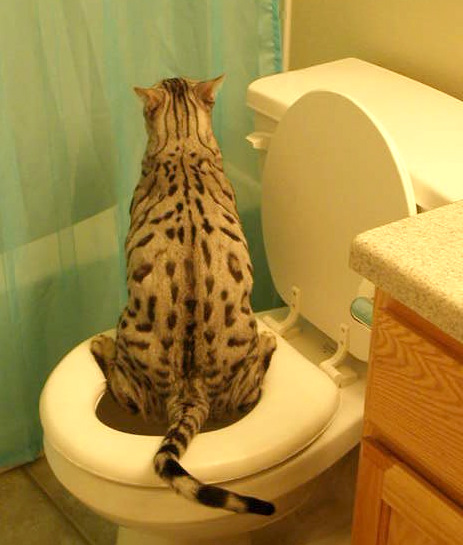Reasons You Must Never Flush Cat Poop Down Your Toilet - Important Facts
Reasons You Must Never Flush Cat Poop Down Your Toilet - Important Facts
Blog Article
This great article which follows on the subject of Don’t flush cat feces down the toilet is quite informative. Have a go and make your own personal findings.

Introduction
As cat proprietors, it's important to be mindful of how we throw away our feline close friends' waste. While it might appear practical to flush pet cat poop down the bathroom, this technique can have damaging consequences for both the atmosphere and human health and wellness.
Ecological Impact
Purging pet cat poop introduces dangerous pathogens and parasites into the water, posing a substantial danger to marine ecological communities. These contaminants can adversely impact marine life and concession water quality.
Wellness Risks
In addition to environmental problems, flushing feline waste can likewise position health and wellness risks to human beings. Feline feces might consist of Toxoplasma gondii, a parasite that can trigger toxoplasmosis-- a possibly severe health problem, specifically for expectant ladies and individuals with damaged immune systems.
Alternatives to Flushing
Fortunately, there are safer and more liable means to take care of feline poop. Consider the adhering to alternatives:
1. Scoop and Dispose in Trash
One of the most usual method of dealing with feline poop is to scoop it right into a naturally degradable bag and toss it in the garbage. Be sure to use a specialized clutter inside story and dispose of the waste promptly.
2. Use Biodegradable Litter
Opt for biodegradable cat clutter made from products such as corn or wheat. These clutters are eco-friendly and can be safely gotten rid of in the garbage.
3. Bury in the Yard
If you have a backyard, think about hiding pet cat waste in a designated location away from veggie yards and water resources. Make certain to dig deep enough to stop contamination of groundwater.
4. Install a Pet Waste Disposal System
Invest in an animal waste disposal system particularly designed for cat waste. These systems utilize enzymes to break down the waste, reducing odor and environmental impact.
Final thought
Liable pet dog possession prolongs past supplying food and sanctuary-- it likewise includes appropriate waste administration. By refraining from flushing pet cat poop down the toilet and opting for alternative disposal techniques, we can reduce our environmental impact and secure human health and wellness.
Why Can’t I Flush Cat Poop?
It Spreads a Parasite
Cats are frequently infected with a parasite called toxoplasma gondii. The parasite causes an infection called toxoplasmosis. It is usually harmless to cats. The parasite only uses cat poop as a host for its eggs. Otherwise, the cat’s immune system usually keeps the infection at low enough levels to maintain its own health. But it does not stop the develop of eggs. These eggs are tiny and surprisingly tough. They may survive for a year before they begin to grow. But that’s the problem.
Our wastewater system is not designed to deal with toxoplasmosis eggs. Instead, most eggs will flush from your toilet into sewers and wastewater management plants. After the sewage is treated for many other harmful things in it, it is typically released into local rivers, lakes, or oceans. Here, the toxoplasmosis eggs can find new hosts, including starfish, crabs, otters, and many other wildlife. For many, this is a significant risk to their health. Toxoplasmosis can also end up infecting water sources that are important for agriculture, which means our deer, pigs, and sheep can get infected too.
Is There Risk to Humans?
There can be a risk to human life from flushing cat poop down the toilet. If you do so, the parasites from your cat’s poop can end up in shellfish, game animals, or livestock. If this meat is then served raw or undercooked, the people who eat it can get sick.
In fact, according to the CDC, 40 million people in the United States are infected with toxoplasma gondii. They get it from exposure to infected seafood, or from some kind of cat poop contamination, like drinking from a stream that is contaminated or touching anything that has come into contact with cat poop. That includes just cleaning a cat litter box.
Most people who get infected with these parasites will not develop any symptoms. However, for pregnant women or for those with compromised immune systems, the parasite can cause severe health problems.
How to Handle Cat Poop
The best way to handle cat poop is actually to clean the box more often. The eggs that the parasite sheds will not become active until one to five days after the cat poops. That means that if you clean daily, you’re much less likely to come into direct contact with infectious eggs.
That said, always dispose of cat poop in the garbage and not down the toilet. Wash your hands before and after you clean the litter box, and bring the bag of poop right outside to your garbage bins.
https://trenchlesssolutionsusa.com/why-cant-i-flush-cat-poop/

I'm just very intrigued by How to Dispose of Cat Poop and Litter Without Plastic Bags and I really hope you enjoyed our page. Sharing is caring. You won't know, you may be helping someone out. Thanks a lot for going through it.
Click Here Report this page